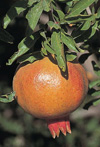

Pomegranate fruit, with its distinctive persistent calyx, in Cana, Galilee, Israel.
POMEGRANATE, PUNICA GRANATUM, is one of the provisions of Allah: “It is He who sends down water from the sky with which We bring forth the buds of every plant. From these We bring forth green foliage and close-growing grain, palm-trees lade with clusters of dates, vineyards and olive groves, and pomegranates alike and different. Behold their fruits when they ripen. Surely in these there are signs for true believers” (Sura 6:99, Dawood). There are three references to this widely grown fruit in the Quran.
Pomegranate is referred to 17 times in the Bible. Of the “six species of the land” in Deuteronomy 8:8, pomegranate is certainly the most beautiful. In addition to fruit production, the shrub is planted in many parts of the world as an ornamental, and dwarf varieties with large flowers have become popular with gardeners. When grown for its fruit, pomegranate has many stems arising from the base, with small, dark leaves; it can reach a height of about 3 meters (about 9 feet). Pomegranate trees requires little care compared to other fruit trees, so they are often planted in marginal areas where they still produce fruit.
The flowers, produced in the spring, are strikingly beautiful, with a bright red-orange color and delicate bell shape. They are used in folk medicines, including for childbirth, perhaps because the flower shape has a fanciful resemblance to the uterus.
Pomegranate fruits in July, near Ajlon, Jordan.
The fruits begin to mature in the first half of August. They are large, up to 15 centimeters (6 inches) across. As noted in the Quran verse, there are many varieties of pomegranates. Some are sweet and eaten as a dessert. Others are tart and are used either as a substitute for lemon in cooking or to make a refreshing drink. Each fruit contains hundreds of hard, small seeds. Unlike most seeds, which have a seed coat that is hard and durable, like bean, the outer seed coat of the pomegranate is fleshy and is the source of the juice that makes the fruit desirable. The unique, fleshy seed coat in pomegranate, known technically as a sarcotesta, is widely used in the Middle East to prepare a pleasantly sour drink, as referred to in Song of Solomon: “I would give you spiced wine to drink, the nectar of my pomegranates” (Song of Solomon 8:2b, NIV). The juice contains as much as 17 milligrams per kilogram of oestrone, a compound being investigated for advantageous properties in cancer research (Fernandes-Carlos et al. 1997).
The tough, leathery rind of the pomegranate fruit is crimson and other colors of red. Because of the rind’s high tannin content, it has been used to tan leather. And the red flesh is sometimes used to dye cloth and carpets.
Pomegranate imagery is prominent in two places in the Bible: the garment of the high priest and in the temple. Bells and pomegranates alternate on the skirt of the high priest: “And on the skirts thereof thou shalt make pomegranates of blue, and purple, and scarlet, round about the skirts thereof; and bells of gold between them round about” (Exodus 28:33, KJV). Engraved on the capitals of the two pillars at the front of Solomon’s temple were 200 pomegranates. Above the pomegranates were lilies. When the Children of Israel were taken into captivity, the pomegranates on the pillars are specifically mentioned (Jeremiah 52:22–23).
The Song of Solomon contains several references to pomegranates, no doubt because of the symmetry and beauty of the fruit: “Your temples behind your veil are like the halves of a pomegranate” (Song of Songs 4:3a; 6:7; NIV); “Your plants are an orchard of pomegranates with choice fruits” (4:13a, NIV); “I went down to the grove of nut trees to look at the new growth in the valley, to see if the vines had budded or the pomegranates were in bloom” (6:11, NIV); and, “Let us go early to the vineyards to see if the vines have budded, if their blossoms have opened, and if the pomegranates are in bloom—there I will give you my love” (7:12, NIV).